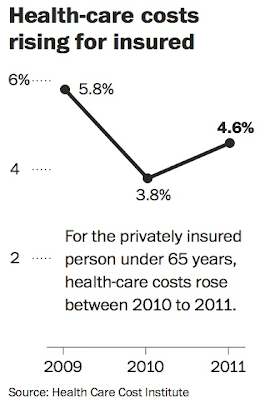Why should you care?
Commercial health care costs are going up - does it matter whether price or patient volume is to blame?
Yes. The Town Hall meeting at the recent Florida Physical Therapy Association (FPTA) meeting included discussion about Copayment reform legislation in Florida.
Some voices in the Town Hall argued that Copayment reform legislation in Florida is not necessary since rising physical therapy utilization indicates there are no barriers to patient access to physical therapists.
Increasing health care costs, to employers via premiums and to employees in the form of rising Copayments, reduce access to physical therapist services.
Do we want to live in an America where only the rich or the employed have access to physical therapist services?
The findings of the Health Care Cost Institute from September 2012 found that
"... price growth for outpatient facilities and professional procedures remained higher than (patient volume) utilization growth.".The prices paid were the primary drivers of health care spending in 2011.
According to a September 25th Washington Post article:
"Employers typically have tried to control costs by reducing the volume of care delivered, whether that means higher co-pays for doctor visits or using prevention to catch costly diseases earlier."Copayment reform for physical therapy patients was a "slam dunk" in Kentucky, South Dakota and New Jersey in 2011 and 2012.
Other state physical therapy associations have not seen the same rapid success with Copayment reform. There is not even uniform agreement that Copayment reform is necessary for patients. Florida is one example where there is disagreement.
Some other opponents of Copayment reform at the recent Town Hall meeting in Daytona Beach spoke out and suggested that insurance companies would "get mad" at the FPTA if we, as an organization, supported Copayment reform.
These opponents, who are physical therapists, are supporting the insurance companies because the insurance companies support them.
When insurance companies set the political agenda for the FPTA we are allowing them to put profits before patients. We need Copayment reform to protect patients. From the Post article:
"Some economists have argued that government regulation is exactly what we need to slow price growth and ensure patient access.
Maryland is the only state in the USA where the government sets the rates that hospitals can charge insurance companies.
Maryland's hospitals from 1977 to 2009 experienced the lowest cumulative increase in cost per adjusted admission of any state in the nation. And private insurers pay the same rates as public insurers.
All states except Maryland gravitated away from those models, as states have looked for more competition and less regulation in health-care markets."Consumers will continue to need physical therapy services and employers will continue to buy lower priced health care with lower premiums for their employees. This means higher Copayments.
This problem wont go away and it can't be solved through "free market" methods.
States need legislative reform that lowers Copayments for patients.





0 komentar:
Posting Komentar